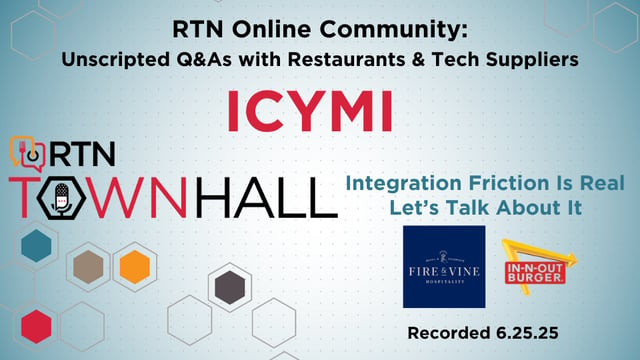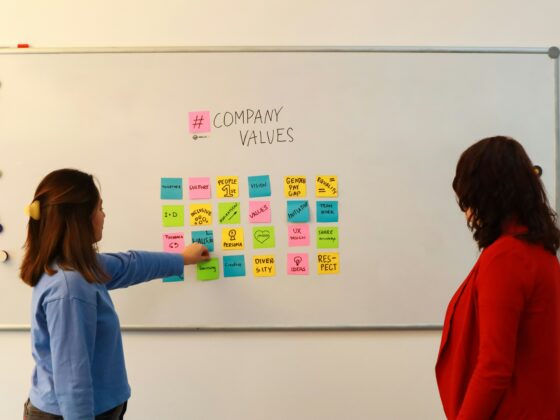
He didn’t mince words: “The payments are the bane of the existence of restaurants. They’ve gone nothing but up.” Mackay has even lobbied in Washington, D.C., on the issue, sharing this alarming fact: “Credit card processing fees have now exceeded as a percentage of my revenue—more than all of our 401K, all of our healthcare, all of our dental care for all of our employees. It’s a bigger percentage now. And it just is getting bigger. And I want to change how that happens because we cannot live in this ecosystem forever.”
Call for Transparent Pricing
Mackay called for transparent, up-front pricing. “Ultimately, the software vendors have to make money, too. As an industry, we’ve got to figure out an ecosystem where everybody makes money…And so just being more intentional as an industry about how the heck are we going to build all this great stuff, and how do we pay for it. And our budgets are not going to be going down on tech. They’re going to go up.”
Patrick Bobrukiewicz, from Nigel POS/Thrive Restaurant Group, strongly agreed with Mackay, pointing out that operators contribute to the problem by always seeking the cheapest software. He described an early question when joining Nigel, a cloud-based POS: “Do you want to make money in payments, hardware, or API fees?” His answer was “no, no, and no. We provide innovative SaaS solutions to restaurant operators.” This highlights the conflict when “everybody wants to augment their income stream with payments.” Bobrukiewicz emphasized, “We absolutely have to find a way to collectively get really great software into our stores in a way that makes sense for both our vendor partners and for the restaurant side and do it transparently.”
The Need for Flexibility
Henshaw of In-N-Out Burger shared his frustration with locked-in solutions. For a decade, he’s worked to select hardware that fits In-N-Out’s unique operational flow. “What we try to do… is customize for what our operations flow that works for us, hardware-wise, software-wise,” he explained. “When we are looking for solutions, we are looking for stuff that is not going to lock us in. We need something that gives us the flexibility to take this cable and go with this printer and go with this terminal, so we can kind of mesh it all together and customize it the way we need it.”
Epson’s Livesay, transitioning from the consumer side, found it “eye-opening” to discover how flexible options, like different APIs for operators and partners, could empower customization. “One solution may not be the best solution for everybody, and then there’s got to be different ways to get around it,” Livesay noted.
Rom Krupp, CEO of OneDine, who’s overseen over 150 integrations, identified three primary areas adding complexity:
- Lack of standardization: “This creates numerous complexities, though organizations like RTN are trying to address it.”
- Business openness: “Some service providers choose not to be as open as one might desire. This can be for a few reasons: they might want to better control their ecosystem and monetize their client base, or they could have significant technical debt, making it a substantial investment for them to become more open – an investment they’re not yet willing to commit to financially or timeline-wise.”
- Economics: “We’ve been in a race to the bottom on SaaS pricing for a while, forcing service providers to become more and more affordable… They might do this upfront by requiring customers to purchase payment services from them, which essentially supplements their profitability. Alternatively, it could be a backend relationship where they tax integration partners with large revenue shares, one-time fees, or ongoing fees… This, in turn, increases costs that get passed back into the market.”
Krupp summarized, “These are the three major challenges we constantly struggle with when trying to create openness in restaurant tech. It’s just the current state of the union of what’s happening in restaurant tech.”
Oracle’s Amber Trendell echoed Krupp’s call for standardization. “It’s going to be even more challenging for brands to adopt new capabilities, particularly AI, if we don’t prioritize openness, documentation, and standardization. Now is truly the time to get serious about these things.” She also stressed the “immense importance of data structure, data schema, and data integrity as we move towards an agent-led world,” noting that “if we don’t get these fundamentals right… it will be incredibly difficult for brands to adopt new technologies.”
The Operator’s Challenge
Russell Cotter, Enterprise Architect at Chipotle, emphasized that operators must properly assess their needs and vet solutions. “For the most critical capabilities of your enterprise, as much as you have a tech-first problem to solve with interfaces working, you really need to step back and say, ‘This is a critical part of our business.’ You need to fully understand its value, risk, changeability, and interoperability for the future.” He cautioned that a lack of upfront design leads to “scrappy workarounds.” When evaluating vendors with open APIs, Cotter advised, “you have to look at what you’re trying to get out of it. Make sure you understand the cost, if there is one, along with the data transmission times, restrictions, and how the rules work so you aren’t surprised in the end.”
Tony Fernandez, CEO of MTech Mobility, thanked RTN for hosting the eye-opening discussion. “This discussion has been great so far. I’ve been quietly listening, and the feedback coming from the restaurant operators is absolutely excellent. It’s truly stuff we all deal with every day. It’s interesting how the conversation shifted to the financial side, and thinking about different ways of paying for things—I totally agree with and support that dialogue.
“Ultimately, it’s not a one-size-fits-all world for restaurant technology solutions. At the end of the day, restaurant operators are trying to find the right solution set for their specific operations, their specific brand, and their specific customer experience. As a solution integrator, we’re kind of like a fish out of water. We work with restaurants and all the different suppliers and vendors to help them navigate what we call the ‘Rubik’s Cube.’ Everyone has a different Rubik’s Cube, and their colors are all different at any given time regarding the various solutions. But ultimately, it always comes back down to the objectives of that restaurant brand and the customer experience they’re trying to achieve.”
Driving adoption of RTN’s industry standards, developed by the industry for the industry, is crucial, as Cacy Bedoka of Jack In The Box pointed out: “We absolutely need to encourage our vendor partners to leverage the standards that the RTN Work Groups have developed.” However, she added, operators also bear responsibility. “I think we need to have more operators being part of this and helping drive adoption. Creating standards without adoption is a waste of everyone’s time.” She urged treating standards as “iterative development like a living document,” acknowledging the “paradigm shifts” required within companies to truly embrace them.
Lorden reminded attendees that RTN Standards, including the RTN Open API Framework, were developed through vendor and supplier collaboration within RTN Work Groups and are publicly available on the RTN website under Technical Documentation. “It is a mission of ours to make sure that folks know how to get their hands on it,” she said, adding to reach out to RTN with any questions.
Get Involved
This is just an excerpt from the hour-long RTN Town Hall. You can watch the full video recording below.
Questions about RTN? Reach out to RTN’s Membership Experience Manager Tammy Hanson.
Follow RTN to stay in the loop. Join the conversation on LinkedIn.







